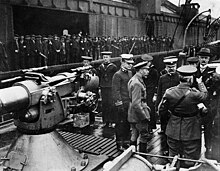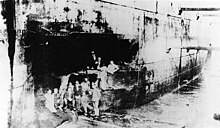Finland (ship)
|
||||||||||||||||||||
|
||||||||||||||||||||
|
||||||||||||||||||||
|
||||||||||||||||||||
|
||||||||||||||||||||
The Finland was a transatlantic passenger steamer of the Belgian-American shipping company Red Star Line that was put into service in 1902 and was used in passenger traffic from Antwerp to New York . During the First World War the ship served under the designation USAT Finland as a troop transport for the United States Army and later as USS Finland (ID-4543) for the United States Navy . After the war, the ship resumed passenger service under the name Finland until it was decommissioned and scrapped in 1928.
Passenger ship in peacetime
In July 1899, the Philadelphia-based shipping company International Navigation Company announced that it was planning four new ocean liners for the North Atlantic traffic . Two of these, the two 11,000-tonne Zeeland and Vaderland , were built at the John Brown & Company shipyard in Clydebank near Glasgow , while the other two, the Kroonland and the Finland , were built two years later by William Cramp and Sons in Philadelphia (USA) originated. All four ships were built for the Red Star Line, which was part of the International Navigation Company. With 12,760 GRT each, the Finland and the Kroonland were the largest ships of the Red Star Line until then.
The Finland , 170.69 meters long and 18.35 meters wide , had two chimneys, four masts and two propellers . She was equipped with two three-cylinder triple expansion steam engines, which allowed a cruising speed of 15 knots. She had a passenger capacity of 342 passengers in the first, 194 in the second and 626 in the third class. After completion in September 1902, the Finland left New York on October 4, 1902 for her maiden voyage to Antwerp .
The Finland steamed under the American flag from Antwerp to New York until she came under the Belgian flag in January 1909. From March to June 1909 she was chartered by the White Star Line and used for three tours from Naples to New York. Then she ran again from Antwerp to New York. In January 1912 she came under the American flag again. In November 1914, she was relocated to the New York – Naples – Piraeus route for three trips . On March 24, 1915, after the third trip, she left for New York.
In May 1915, the Finland and the Kroonland were temporarily chartered to the Panama Pacific Line, for which they drove from New York via the Panama Canal to San Francisco . It took around 17 days for each trip, with a stopover in either Los Angeles or San Diego . Next, the Finland was chartered to the American Line, for which she commuted between New York, Falmouth and London from October 26, 1915 . After two Atlantic crossings on this route, she returned to the Liverpool – New York route on January 19, 1916. At this time, the ship was already armed with four 100 mm guns, which were operated by members of the United States Navy Armed Guard.
Olympic Games 1912
The United States Olympic Committee (USOC) chartered the Finland to the US team to the 1912 Summer Olympics to Stockholm to bring. On June 14, 1912, she ran out of New York with the 164-strong delegation. With the help of the team, the athletes set up several training opportunities on board, which were used during the trip to prepare for the games.
For example, a 91 meter long running track was set up on the upper deck, on which two men could sprint side by side. The swimmers practiced in a swimming pool specially set up on deck. Bicycles were mounted on the front deck for cyclists . Finland reached Antwerp on June 24, 1912 . Two days later she left for Stockholm, where she arrived on June 30th.
Incidents
In November 1907, the ship almost went aground in strong winds in the English Channel . Only the quick deployment of two tugs saved the Finland from being stranded on the breakwaters at Dover . On January 19, 1908, the Finland collided with the Greek cargo steamer Epirus near Terneuzen on the Dutch coast , which sank after the collision. On December 25, 1910, she collided with the Baltique near Vlissingen , which was anchored there seeking protection from a storm. This ship also went down.
Troop ship in the First World War
In April 1917 the United States declared war on Germany . The United States Army now needed ships that could bring soldiers and war material to France. On May 28, 1917, a committee convened for this purpose selected 14 American-registered ships for this purpose, including the Finland . After the Finland had unloaded her last passengers, she was handed over to the US Army on June 2, 1917 as the last of the 14 selected ships.
Within just two weeks, the Finland was converted for military service. All second and third class accommodations were dismantled and replaced with dormitories. In addition, more sanitary and cooking facilities had to be created for the large number of men. On June 14, 1917, the Finland cast off in New York with the 18th Infantry Regiment on board under the command of Rear Admiral Stephen Graham for Brest . Numerous other troop trips from New York to Europe followed.

On October 28, 1917, on her way back to New York , the Finland was hit by a torpedo from the German submarine U 93 about 150 nautical miles off the French coast . Among other things, she had the survivors of the Antilles on board, an American troop transport (ex-passenger steamer) that had been sunk by U 105 eleven days earlier . Panic broke out among the civilian crew and survivors of the Antilles , as another shipwreck appeared to be imminent. The Finland indeed got list to starboard, but did not sink.
After extensive repairs, the Finland set off for the next voyage on January 5, 1918. She was handed over to the United States Navy on April 24, 1918 and officially entered service two days later. By the end of the war she carried out five troop trips for the US Navy, during which she brought a total of 12,654 soldiers to France. After the war ended, Finland made eight crossings to bring American soldiers back to the United States. 32,197 soldiers returned home on the Finland . On November 15, 1919, the ship was released from the service of the US Forces and transferred to the United States Department of War , which in turn handed it over to the Red Star Line.
Late years
In April 1920 the Finland resumed its civil service. After intensive renovations, 242 passengers could now be carried in first, 310 in second and 876 in third class. On April 28, 1920, the steamer left Antwerp on its first post-war voyage to New York via Southampton . After three years on this route, the Finland and her sister ship Kroonland were chartered to the American Line again.
After changing the passenger capacity to cabin class and third class, the ship operated from June to September 1923 on the route New York - Plymouth - Cherbourg - Hamburg . From September 29, 1923, the Finland drove again for the Panama Pacific Line from New York to San Francisco via the Panama Canal. The Kroonland joined in the following month. When the Panama Pacific Line added two new ships, the California and the Virginia , to their fleet in 1928 , the Finland and Kroonland were no longer needed and were sold for demolition. On April 28, 1928, the Finland arrived at the Hughes Bolckow Shipbreaking Company in Blyth , where it was scrapped.
Web links
- Information and images to the ship (English)
- Two postcards with Finland as a motif (English)



